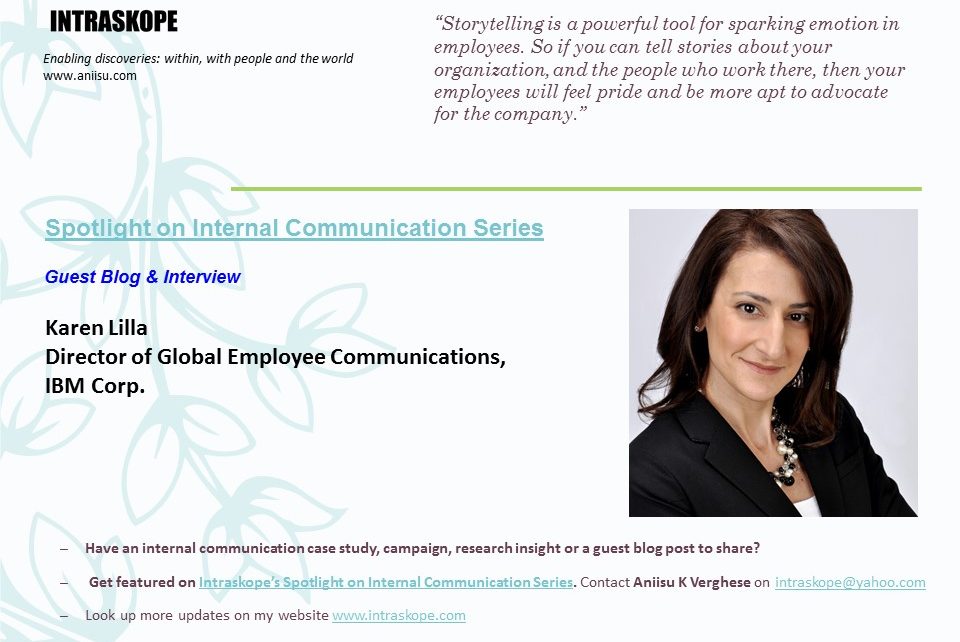Does data play a role in improving employee experience? What skills are important for internal communicators? How can internal communicators manage crises?
Benefit from answers to these questions and other insights in the 22nd edition of Intraskope’s Spotlight on Internal Communication Series featuring Karen Lilla – Director of Global Employee Communications, IBM Corp.
For the past five years, Karen has led a global team to shift the culture of the 100+ year old IBM company, instilling pride and engaging the 380K + workforce. She has extensive experience in public relations, crisis communications, mergers & acquisitions and change management. Karen is based in Cambridge, Massachusetts, USA.
Read on and share your feedback.
Interview
What does internal communication mean to you?
“Internal communications” is an often mis-understood term. Many organizations treat the internal communications function as an extension of media relations, marketing or HR. I’ve even seen internal communications at one organization report up into their Legal department!
I believe internal communications is about instilling pride in an organization’s employees, helping them understand and see themselves in the company’s strategy so they can be advocates for the company with their networks. Internal communications is a two-way role, meaning the practitioner can’t be successful unless they doing a combination of sharing details about the company (push) and also LISTENING to the employees — engaging with employees in a two-way dialog.
How is it practiced in your organization?
At IBM, “employee communications” is a discipline within the Communications function of the company. We have employee communications professionals around the globe, creating experiences that help our employees be advocates for IBM. There are employee communications professionals collaborating with the most senior leaders of the company, engaging employees in business units, by discipline (technical, sales, etc), on regional and country-levels.
Please share an example/campaign that you are personally proud of working on and that made a significant impact to your organization.
A few years ago, we hosted a company-wide “jam” to identify how we create the best experiences for our clients. The output of this multi-day online collaborative experience were behaviors, or practices, that all IBM employees demonstrate when we show up at our best in front of clients. Engaging the entire company in the jam was a tremendous feat, but even more exciting was taking the output of the Jam, the nine behaviors all employees exhibit, and embedding it throughout the IBM system, from recognition to HR programs to leadership development to executive communications to a new storytelling apps. To help IBM managers learn how to be the best managers they can be, we supplemented the traditional manager development curriculum with a digital communication platform to help managers share advice and get advice from each other, while reinforcing understanding of our strategy and these behaviors identified in the Jam. In the first year, 82% of managers participated in the app, so our team was very pleased.
What is the biggest challenge you face while going about managing internal communication?
At IBM, the biggest challenge we face is our size. We have amazing employees, doing innovative things that are truly changing the world. It’s a real treasure trove of stories that we can share both internally and externally. Helping our employees learn about their colleagues, and the amazing work happening inside the company, is a 24×7 job. There are a lot of distractions in a company of our size, so cutting through the noise and creating impact is challenging.
What according to you is the biggest opportunity that internal communicators have?
Data. As a discipline, we can greatly improve the open and click through rates of emails, visits and retention of intranet content, views of videos, participation in programs, and overall engagement of employees if we gather, analyze, and make decisions based on the wealth of data at our fingertips.
How can internal communicators add more value to the business?
I believe the internal communications discipline has a lot to learn from our marketing colleagues who have a data-driven approach to campaign management.
What is your advice for people who are keen to join internal communication and make a career? What skills must they have or develop?
Writing skills is definitely a must for any communications profession. But I think more important than writing is the ability to tell a story, whether it’s with words or visually. Storytelling is a powerful tool for sparking emotion in employees, so if you can tell stories about your organization, and the people who work there, then your employees will feel pride and be more apt to advocate for the company.
Blog
Crisis communications and your employees
Natural and man-made disasters are in the news daily, impacting countless lives around the globe. Whether you are a communications professional at a start-up, small to mid-sized company, enterprise, or organization in the public sector, there will come a time when you need to activate an emergency plan.
When highly visible tragedies occur, the pressure to respond immediately is immense. The natural tendency is to focus on messaging for external audiences – the media and clients.
But what about employees?
Employees have needs too, and if well informed, can be advocates for your message.
Communications professionals should have a plan in place before a tragedy occurs, that focuses on how you will engage employees in times of crisis. At a minimum, the plan should include answers to these questions:
- How and when will the company communicate to employees about emergencies?
- Do you have specific initiatives to enable personnel to work from home or remote locations?
- What mechanisms are used to contact employees and how will the company account for employees during an emergency?
- Should employees self-identify if they are safe, or need assistance?
1) A method for the core team to communicate, such as WhatsApp or a list of mobile phone numbers.
Don’t forget to add delegates in case a team member is unavailable. There should be no guessing during an emergency who the decision makers are and how to reach them.
2) A set of guiding principles for the management team to adhere to in times of crisis. For example:
- “We work as one team across HR, Security, Communications, to prepare fact-based communications.”
- “We act with speed and don’t stay silent. When we’re not ready to share specifics, we assure employees we’ll share when we can.”
- “We will not comment on an employee’s death without explicit permission from the family.”
3) A checklist, timeline or workflow to guide the team. Think through various crisis scenarios, and document the steps you would take to manage communications to employees during that incident. Patterns will emerge that you can follow during an emergency.
With a plan in place, you will be prepared to engage your employees in time of crisis. Providing timely and
fact-based messaging will engender trust with the leadership team, and enable your employees to be
advocates, not antagonists, for your company.
Missed previous stories from organizations featured on the Intraskope’s Spotlight on Internal Communication Series? Look them up here – Infosys, SOBHA Ltd., ICICI Securities, First Advantage, CK Birla Group, TVS Motors, GE, Suzlon, Tata Sons, Percept, Knight Frank, TCS Europe, Vedanta, Oxfam, Danske Bank, Diageo, Pandora, Symantec, ISS Global Services, Telia and Thomson Reuters.
Intraskope (www.aniisu.com) is the first blog on internal communications in India and among the earliest around the globe. Begun in 2006, the blog has over 530 posts on topics such as employee engagement, leadership communication and employee branding and receives thousands of visits from across the world. The blog, receives over 50,000 visits every month from over 50 countries globally, offers learning resources for practitioners, academicians, and students including industry workshops, research reports, and checklists. Intraskope has been featured on leading global internal communication forums like Simply-Communicate, IC Kollectif and International Association of Business Communicators. It is hosted by Aniisu K Verghese, author of Internal Communications – Insights, Practices & Models (Sage, 2012).
If you are an internal communication leader working in a firm or a not-for-profit anywhere in the world and have an internal communication case study, campaign, research insight or a guest blog post to share please contact me on [email protected]
You can also visit my website www.intraskope.com and You Tube channel to know more about my work

